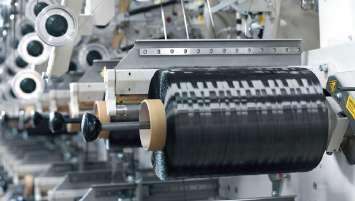COMPANY UPDATE
49
SUSTAINABLE AND INTELLIGENT: THE TC 19i SETS THE BENCHMARK FOR ENERGY-EFFICIENT CARDING Trützschler GmbH & Co. KG
Global energy consumption reached a record high in 2019, following a 40-year trend of rapidly increasing energy demand that was only halted by the coronavirus pandemic. 1stIt’s estimated that more than 80 percent of this energy is still generated from fossil fuels that produce CO2 emissions and contribute to climate change. 2ndRenewable energy offers a solution to this problem, but saving energy whenever possible is an even more effective approach. That’s why Trützschler has developed the intelligent card TC 19i, which sets a new benchmark for energy-efficient carding.
and cotton waste mix. The compared energy values included electric power consumption and energy required for suction and compressed air and were measured in both cards at the same production of 180 kg/h. A 10% reduction in energy per kilogram of sliver produced, as proven here by TC 19i, can have a significant impact on a spinning mill’s profitability; annual savings worth a five-digit sum are frequently possible, depending on factors such as the output of the mill.
Only the intelligent Trützschler card TC 19i features the unique T-GO gap optimizer, which continuously and automatically monitors and adjusts the carding gap to an ideal position during production. By now, more than 2000 intelligent cards sold worldwide prove quality and production leaps in the double-digit percentage range daily, thereby reducing energy demand per kilogram produced. 3rd innovative drive-and air technology further reduces energy consumption of the TC 19i. In this way, the TC 19i saves energy to help protect the planet – and also boosts profitability for yarn production. The most energy-intensive elements in a carding machine are the drive, the dust suction process and the compressed air system. Permanent suction is needed to remove dust and cotton waste in key places. In contrast to Trützschler cards, many cards on the market also use compressed air for suction hoods in the pre-carding and post-carding areas, for example. Smart optimization of these areas has made the intelligent card TC 19i a benchmark for energy efficiency in carding because it uses less electricity, lower suction pressure and less compressed air than other machines, while providing the highest production rates currently available on the market. In a head-to-head comparison between the TC 19i and a high-performance card from a competitor, the TC 19i consumed at least 10% less energy per kilogram of material produced when manufacturing rotor yarn from a cotton
Sets the benchmark for energy-efficient carding: the intelligent 19i
The customer trial also showed TC 19i’s excellent reliability at the customer’s usual production rate of 180 kg/h, and even demonstrated stable performance at 300 kg/h in the same application. Because the TC 19i with T-GO gap optimizer realises maximum production rates at no compromise in quality, manufacturers can reduce their energy demand and investment costs drastically: Fewer machines are needed to achieve the desired output, and energy consumption per unit of production is reduced. Energy-efficient air technology Next to increased productivity, air technology plays a pivotal role in the energy balance of the TC 19i. Christian Freitag, Head of Air Technology at Trützschler, explains SEPTEMBER 2021





















